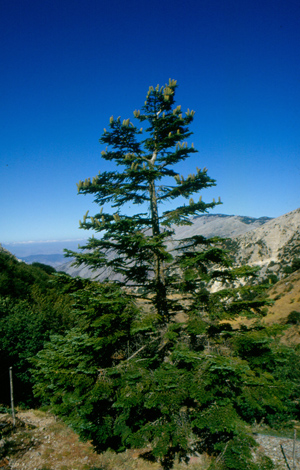Saving the flora of Mediterranean islands -
50 reasons to act now!
by Shirley Walker, Eden Project
Visitors to a Greek island in August, strolling to the beach through a parched olive grove, with only golden grasses and desiccated seed heads around their feet would find it hard to believe that only a few months earlier the ground had been covered in a carpet of wild flowers and herbs, stirred into life by the first winter rains. The countries of the Mediterranean basin share 25,000 different species of flowering plants and ferns and 60 per cent of these are found nowhere else on earth, making it one of the world’s biodiversity ‘hotspots’.
This exceptional diversity, regional variation and high rate of endemism are due in part to the unique climate with its cool, wet winters and long, hot, dry summers. The Mediterranean escaped the worst ravages of the Ice Age, making it a haven for plant life and continued evolution.
However over the last few decades the number of species has declined dramatically in the Mediterranean. Urbanisation, population growth and industrial infrastructure have led to massive habitat loss as have changes in agricultural practices - intensification and the abandonment of traditional terraces. Tourism has also had a detrimental effect, particularly on coastal habitats. Other factors include the spread of alien species and fire, which can be beneficial but can cause untold damage when left to rage out of control. Wild collection of bulbs has led to a decline in these species and more recently, climate change is beginning to have an effect as many plant species rely on specific ecological conditions to survive. All of these factors together have been responsible for the elimination of many native plant species and a reduction in numbers and habitats of others.
Islands are particularly vulnerable to habitat loss. The Mediterranean has nearly 5,000 islands and although many are very small, others cover areas of more than 25,000 km2 and are extremely diverse in geography, geology and altitude. Their remoteness from the mainland has, in the past, allowed new species to evolve and provided protection for others to survive. Traditionally, Mediterranean plants were closely tied to human activity, helping to maintain this richness. Many ancient island plant species have managed to survive while their relatives on the mainland became extinct because they could not compete with the migration of new species into their habitats during the last glacial period. Islands therefore are richer in endemic species than the mainland and this is particularly true of large islands like Crete, Cyprus and Sicily where the rate of endemism can be around 10 per cent - but this is often localised making them extremely vulnerable to extinction.

Abies nebrodensis, by Carlo Columba
Tourism has been destructive on many of the islands, particularly around their coasts and despite conservation measures put in place over the past few years many Mediterranean plant species are still seriously threatened with extinction. The disappearance of one species can lead to ecosystem changes that affect the quality of the environment.
But help is at hand! Because many island plants are on the brink of extinction the ‘Top 50 Mediterranean Plants’ campaign has been initiated by the Mediterranean Islands Plant Specialist Group (MIPSG) to help save plants facing serious risk of extinction by providing information and raising awareness among decision makers, conservationists and the general public. A fascinating booklet has been produced highlighting the ‘Top 50’ – a small selection of plants on the brink of extinction. Readers of the booklet can learn about broader conservation issues and the actions necessary to save thousands of plant species.
Out of around 2,000 plant species found on the island of Crete, 160 are endemic and a small number appear in the ‘Top 50 Mediterranean Island Plants’. One of these is Convolvulus argyrothamnos, found in a limestone gorge; a last refuge for possibly forty individuals of this ancient species.
Cyprus is home to 1,800 different plant species and subspecies and of these 125 are endemic. Like Crete this high rate of endemism is due to its isolation and wide variety of habitats and microclimates. Delphinium caseyi is only found at two sites in Northern Cyprus. A recent expedition only found 15 individuals and most of these had been attacked by grazing animals. It is one of the rarest of Cyprus’ endemics.
The Balearic Islands share a total of 1,280 species with Mallorca being the richest because of its wider range of habitats. However, as Mallorca is much smaller than islands like Crete and Cyprus the rate of endemism is lower at about 3 per cent and the majority of these are in the mountains towards the north of the island. Naufraga balearica occurs only in Mallorca where it is found in steep, shaded crevices near the base of north-facing sea cliffs, and is restricted to areas inaccessible by goats. It is the only species of the Naufraga genus.
The Sicilian fir, Abies nebrodensis, was thought to be extinct in 1900 due to extensive logging and erosion but was rediscovered in 1957. Today a population of only about 30 individuals remains on a steep, dry slope in the north-east of Sicily where they are susceptible to fire.
Limonium strictissimum is endemic to Corsica and Sardinia and is threatened by natural factors such as drought and landslides along the cliffs and small strips of beach where it is found. Trampling by tourists threatens all their sites as does the construction of new resorts.
You can find out more about these and the other endangered species featured in the ‘Top 50 Mediterranean Island Plants’ by visiting IUCN.